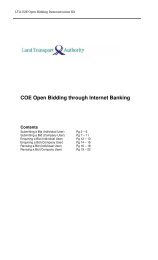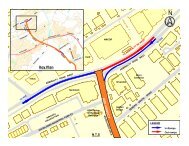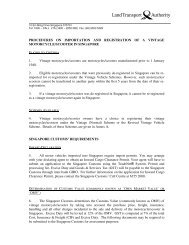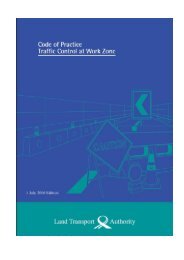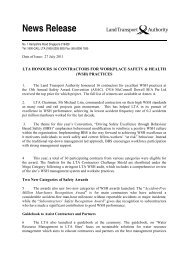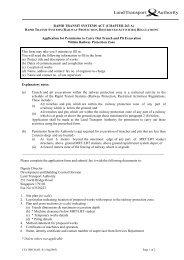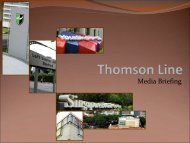ADC Section 5 - Support Design Guidelines - Land Transport Authority
ADC Section 5 - Support Design Guidelines - Land Transport Authority
ADC Section 5 - Support Design Guidelines - Land Transport Authority
- No tags were found...
You also want an ePaper? Increase the reach of your titles
YUMPU automatically turns print PDFs into web optimized ePapers that Google loves.
Page-2/121 INTRODUCTIONGlazing: The complete element of construction comprising the glass, the fixing or frame , gaskets, siliconesealants and tapes.This handbook is intended to aid designers in choosing the most suitable glass and glazing system for usewithin buildings serving Singapore’s Rapid Transit Systems.The correct choice of a glazing system depends on an understanding of :-- The performance of the various types of glass currently available in Singapore.- The effects that the system of glazing have on this.- The dangers inherent in the location in which the glass is used.- The dangers inherent in the size of the glazed panels.- The load on the glazing- The consequences should the glass break.This handbook is intended to be read in conjunction with the following documents:-- The <strong>Authority</strong>’s Glazing Criteria.- The Architectural Materials and Workmanship Specification: ‘Glazing’.- The Civil <strong>Design</strong> Criteria.The <strong>Authority</strong>’s Glazing Criteria take the form of a series of performance requirements together with glazingrecommendations which, if followed, will ensure that the <strong>Authority</strong>’s requirements are met. <strong>Design</strong>ers will berequired to demonstrate that the performance of any proposed alternative systems will either equal, or surpass,the <strong>Authority</strong>’s requirements.Standards referred to in this handbook include:-- SS 341:1989: Safety glazing materials for use in buildings (human impact considerations)- BS EN 1863: 2000 Glass in building – heat-strengthened soda lime silicate safety glass: definition anddescription.- BS 952.1: 1995 Glass for glazing, classification.- BS 5368 Part 1: Air permeability test.- BS 5368 Part 2: 1980 (1986) Weather-tightness under static pressure.- BS 5368 Part 3: 1978 (1985) Wind resistance tests- BS 6262: 1982 B.S. Code of practice for glazing for buildings- ASTM C1036: 1997: Standard specification for flat glass- ASTM C1048: 1997: Standard specification for heat treated flat glass-Kind HS, Kind FT coated and uncoatedglass (note :HS = heat strengthened, FT = flat tempered)- ASTM C1172: Standard specification for laminated flat glass- European draft standard prEN 12337: includes chemically tempered glass. Part 2 defines laminated safetyglass, part 3, laminated glass.- European draft standard prEN 14179; Heat soaked thermally toughened soda-lime silicate safety glass.- European draft standard prEN 1096 Parts 1-4 defines and classifies various applications in terms of thedurability of coatings on glass.- German standard DIN 52290: refers to anti-vandal and anti-intruder tests on glass.- German standard DIN 18361: refers to polished wired glass.- German standard DIN 52290: refers to anti-vandal and anti-intruder tests on glass, and categorises glassaccordingly.- German Standard DIN 18516 Part 4: refers to heat soak tests on tempered glass.July 2009<strong>Section</strong> 5.3 of Architectural <strong>Design</strong> Criteria – Revision A1



